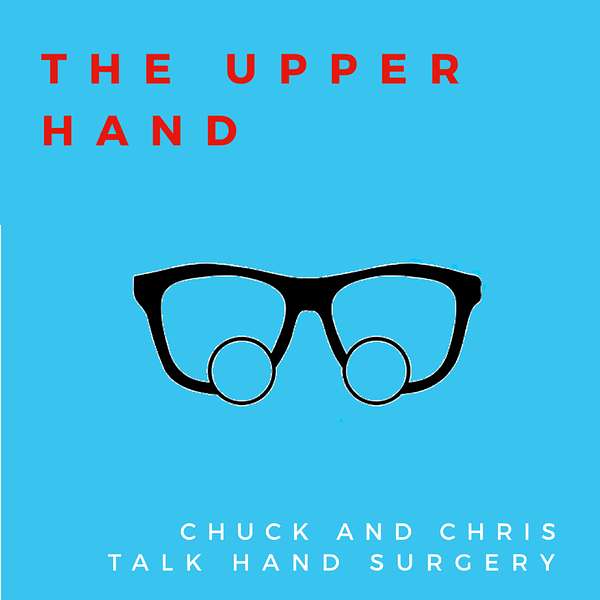
The Upper Hand: Chuck & Chris Talk Hand Surgery
The Upper Hand: Chuck & Chris Talk Hand Surgery
CMCs, OCDs, and Leadership
Chuck and Chris discuss a number of stimulating topics. First up, Chuck shares a case of a large elbow osteochondritis dissecans lesion and the latest in treatment techniques. Next we discuss a listener submitted question on CMC pain in a young patient. And finally, we discuss an HBR article on leadership, particularly pertinent in 2025. Join us!
HBR “The Work of Leadership”. Ronald A. Heifetz and Donald Laurie
Reprint R0111K; Best of HBR, 2001
We have a brand new survey! Please take 2 minutes and help us to better understand your preferences and help us understand how we can continue to improve the podcast!
https://forms.gle/MXmPMwYLYfYa6E347
Keep a lookout for our Summer Newsletter- check your inboxes and let us know if you are not on the list and would like to be. Feedback always welcome.
See www.practicelink.com/theupperhand for more information from our partner on job search and career opportunities.
The Upper Hand Podcast is sponsored by Checkpoint Surgical, a provider of innovative solutions for peripheral serve surgery. To learn more, visit https://checkpointsurgical.com/.
As always, thanks to @iampetermartin for the amazing introduction and concluding music.
For additional links, the catalog. Please see https://www.ortho.wustl.edu/content/Podcast-Listings/8280/The-Upper-Hand-Podcast.aspx
Medical Research and Podcast Planning
Charles and Christopher discussed Talia's new office setup and the current mild weather. They shared personal anecdotes about swimming pools and their children's medical school experiences. The conversation then shifted to the importance of research publications in medical education, with Christopher mentioning that Jake has made progress in this area. They briefly touched on listener questions and upcoming content for their podcast episode.
Osteochondritis Dissecans Treatment Approaches
Charles discussed his experience treating osteochondritis dissecans (OCD) of the capitellum, particularly large cases over 15mm in diameter. He explained that OCD involves loss of underlying bone and detachment of cartilage, often affecting young athletes through multifactorial causes including genetics and overuse. Charles detailed his treatment approach, which includes microfracture for smaller lesions under 1cm, while larger cases may require osteochondral autografts harvested from the knee, though he noted minimal donor site morbidity despite insurance challenges.
Defect Management and X-Ray Indications
Charles discussed a case involving a 15mm defect in a patient, where he used allograft plugs by overlapping two 12mm plugs. He explained that for defects between 9-11mm, he typically uses autografts if insurance approval is possible, while larger defects require allografts. The conversation then shifted to Trip Levitt's question about X-ray usage for thumb CMC arthritis in younger patients, with Charles noting that 40-year-olds are considered young for arthritis and X-rays might be warranted earlier in such cases.
Managing Thumb CMC Arthritis
The discussion focused on managing thumb CMC arthritis, particularly in younger patients. Charles explained his approach of sending younger patients with arthritis to therapy and potentially using splinting, while considering surgery as a last resort. They discussed the use of lidocaine in injections, with Charles noting that while it provides short-term pain relief, it may not fundamentally change the outcome. Christopher inquired about the evidence base for thermal capsularorphathy in thumb CMC arthritis, which Charles suggested could be a helpful procedure in certain cases.
Arthritis vs Laxity Diagnostic Challenges
Charles and Christopher discussed the challenges of diagnosing arthritis versus laxity in young patients, noting that it's a complex issue without clear scientific guidance. They agreed to cover the topic of Eaton ligamentous reconstruction and arthroscopic treatment of the CMC in a future episode. The conversation then shifted to a seminal Harvard Business Review article on leadership by Ronald Heifetz and Donald Laurie, which Charles had recently encountered and planned to reference in an upcoming talk at the AOA meeting.
Adaptive Leadership in Healthcare Challenges
Charles and Christopher discussed adaptive leadership challenges in healthcare, particularly focusing on how academic medical centers are facing funding cuts and operational changes. They explored how these challenges require different approaches than technical problems, involving cultural shifts and requiring leaders to both "get on the balcony" to understand the big picture while also "getting into the fray" to engage with team members. The discussion included examples from both patient care contexts and residency programs, with Charles noting that while the 80-hour work week was a technical challenge, the subsequent cultural shifts in how residents approach their work represent an ongoing adaptive challenge.